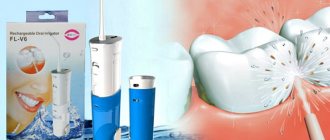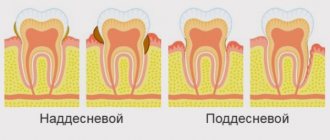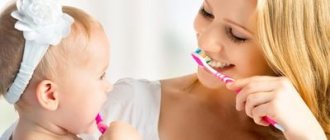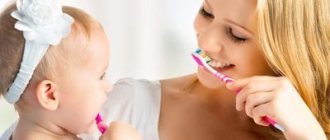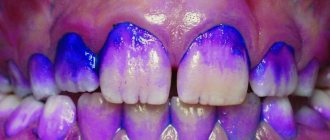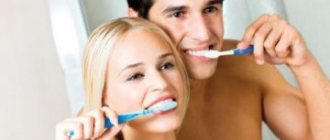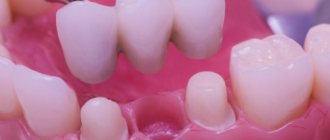Author of the article:
Soldatova Lyudmila Nikolaevna
Candidate of Medical Sciences, Professor of the Department of Clinical Dentistry of the St. Petersburg Medical and Social Institute, Chief Physician of the Alfa-Dent Dental Clinic, St. Petersburg
Teeth brushing is designed to prevent the development of caries, the appearance of plaque, bad breath and other phenomena in the oral cavity. You need to brush your teeth at least twice a day - in the morning (necessarily after breakfast) and late in the evening (before bed). Thanks to this, there will be no food residue left on the teeth, which will lead to the growth of bacteria.
It is also important to observe the interval between breakfast (especially if it is supplemented with orange juice) and hygienic brushing of teeth. This is done because when eating food containing acid, the softness of the enamel increases, and it can be destroyed under the influence of a toothbrush.
Why do you need to brush your teeth?
Oral hygiene is not only a matter of aesthetics. It is due to medical reasons. A plaque constantly forms on the enamel, consisting of: • food particles; • saliva; • waste products of microorganisms inhabiting the oral cavity.
The process of plaque deposition does not depend on whether a person ate in the interval between brushings. If it is not removed, over time it turns to stone. Contamination not only creates a cosmetic defect. Deposits contribute to the violation of the integrity of the enamel. Pathogenic bacteria penetrate into the resulting cracks and actively multiply under conditions of poor hygiene. This is how caries begins with all the known consequences. These microorganisms also attack the gums. In people who neglect to brush their teeth, gingivitis becomes chronic. If the inflammation is not treated, complications in the form of periodontitis and periodontal disease are possible. As a result, the root no longer holds in the socket and the tooth falls out.
How to brush your teeth correctly?
It is a mistaken idea that everyone can do this. There are a number of rules, many of which are either unknown or ignored. However, only compliance with them guarantees effective cleaning of the enamel: • Carrying out hygiene procedures not only at home, but also at the dentist. • Rational selection of brushes and paste. • Using the optimal teeth brushing method. • Using dental floss, brushes and mouthwash. • Taking into account the condition of the gums, the presence of braces and dentures. • Compliance with the rules for storing, cleaning and replacing brushes.
Tablets for determining plaque will help you understand whether you have achieved your goal. They demonstrate whether unwanted deposits are present on the enamel. They also suggest which areas are not being worked through carefully enough.
How to tell if your teeth are brushed well
You can check the quality of teeth cleaning in 2 ways:
- Walk along the inner and outer surfaces of the row with your tongue. Roughness and unevenness on the enamel surface are a sign of insufficient hygiene. Protrusions on the surface of teeth represent unremoved bacterial plaque.
- Use tablets that stain food debris and deposits on teeth. Problem areas are tinted and become more visible.
The main reasons for poor quality care are short use of a brush or the use of low-quality hygiene products.
To maintain dental health, it is important not only to brush your teeth properly. It is necessary to carry out the procedure regularly, for 3-4 minutes. Brushing teeth for children is reduced to 2 minutes.
Choosing a toothbrush
To completely clean the enamel from plaque, you need to choose a suitable brush. The easiest way to do this is by material. There are two options here - natural and synthetic. It is better to give preference to the latter, since they are quite elastic, and the tips of the hairs are usually rounded, which is safer for the gums. Bacteria multiply faster on natural materials.
In terms of the stiffness of the bristles, toothbrushes are: • Soft. They are best taken for children, adolescents and people suffering from gingivitis. • Average. A universal option for people without dental problems. • Tough. They help fight hard plaque and can be used only when indicated.
The configuration of the bristles should be discussed with your dentist. It will tell you where more sediment collects. For example, if you need to better work on the necks of teeth, bristles collected in bunches can handle this.
Pasta selection
Pastes are hygienic, preventive and therapeutic. The first ones solve the only problem - clean the enamel. The latter, due to the antiseptic component, help prevent the development of gingivitis and caries. Still others are prescribed by dentists for therapeutic purposes; it is better not to use them on your own.
Toothpastes are also distinguished according to the results of use: • whitening - slightly lighten the enamel, but you should not expect drastic changes from them; • strengthening – contain fluoride, good for enamel health; • desensitizing - reduce sensitivity; • anti-inflammatory - help with gingivitis.
Abrasiveness characterizes the degree of impact on plaque. The average value of this indicator is from 50 to 80. Higher values can be taken occasionally to lighten teeth. Lower abrasiveness is indicated for sensitive enamel and gums.
Therapeutic and prophylactic pastes
These pastes contain substances that have an antibacterial effect. Their effect is to reduce inflammation and prevent the development of caries. Such pastes should be purchased on the recommendation of a specialist in pharmacies.
Such pastes are divided into:
- Contains extracts of medicinal herbs and essential oils that help relieve inflammation and accelerate tissue regeneration processes. The essential oils in the composition help eliminate bad breath.
- Containing minerals and salts, which helps strengthen tooth enamel, accelerate tissue healing and reduce plaque formation.
Proper brushing of teeth: sequence of movements
For hygiene purposes, you need to accustom yourself to a certain sequence of movements.
After squeezing the paste onto the brush, you must: • apply it to the teeth at an angle of 45 or 90 degrees; • pass each one 3-4 times in the direction from the gums to the cutting edge; • treat chewing surfaces with circular movements; • Allow at least 30 seconds of brushing for each half of the jaw. Depending on the location of the brush and the direction of movement, there are three methods of brushing teeth. The most famous (90 degree brush, top to bottom movements) is the Leonard method.
The Bass method involves choosing an angle of 45 degrees and making vibrating movements. It is good because the bristles penetrate into the interdental spaces and partially work out the contact surfaces. With the Fones method, an angle of 90 degrees is taken and the brush moves in a circle. This further massages the gums, which improves blood circulation and protects against inflammatory processes.
Caring for your teeth after professional cleaning
Based on the results of the procedure, the doctor should give recommendations on proper hygiene. Basic Rules:
- For several days after medical procedures, it is important to clean the teeth not only twice a day, morning and evening, but also after each meal. If this is not possible, it is enough to rinse your mouth with clean water or a special mouthwash.
- The paste and brush should be carefully selected depending on the patient's needs. If in doubt, consult your dentist.
- You need to stop eating hot and cold for a while. This is due to increased sensitivity after external exposure.
- You must completely abstain from smoking for at least 3 days. This way the natural whiteness of the enamel will remain for a long time.
- It is advisable to exclude coloring foods and drinks (tea, coffee, chocolate) from the menu.
- You can’t eat too sour and sugary foods, or chew nuts or candy.
- If the process has been completed with fluoridation, a minimum of two hours of abstinence from food and refusal of standard evening brushing and toothpaste are indicated.
Despite the fairly broad list of recommendations, patients should understand that any medical procedures will be effective when carried out on a regular basis. All pathological processes developing in the oral cavity are easier to prevent than to treat later. For this reason, you should not neglect the advice of professionals and be lazy in caring for your incisors, canines, molars and mucous membranes in your mouth.
How to determine whether you need to have your teeth professionally cleaned by a dentist, and why you should go to him
This is very easy to do - just look into your mouth and assess the condition of your teeth. If the enamel has acquired a yellowish tint, there are brown or grayish spots on it, the gums are swollen and bleeding, they hurt, or there is an unpleasant odor, then you should definitely look into the dental office.
At the same time, do not wait for the symptoms listed above to appear. If pathological processes are started, cleansing will not help. It is for this reason that it is important to have incisors, canines, molars and soft tissues cleaned by a hygienist as a preventive measure.
How often should you have professional teeth cleaning?
There is no clear answer to this question. If the procedure is necessary for preventive purposes to prevent carious lesions, increase the service life of installed filling material, dentures and other elements, then a visit to the clinic once every six months will be sufficient.
Sometimes they resort to cleansing more often, it all depends on the specifics of the case. Smokers, people who drink alcohol, and those who have problems with the digestive organs or bite are included in a separate category. Under such conditions, plaque and stone form much faster.
If prosthetics were performed, teeth should be cleaned at the dentist every 3-4 months. The same goes for people with periodontitis affecting the subgingival pockets. The procedure is performed by a periodontist, as it requires special knowledge and special instruments.
It is important to pre-treat caries and other oral diseases. Only after this will it be possible to evaluate in practice what professional teeth cleaning in dentistry provides.
How much does it hurt
Normally there should be no pain. However, some patients claim that when removing deposits they felt unpleasant and even painful. Some discomfort may be present, this is due to pathological processes such as inflammation of the gums and exposure of the cervical and root parts.
Pain is also possible when the hygienist gets rid of stone in the area of periodontal pockets. If the mineralized layer is too thick, this is also possible. The clinic uses anesthetics that will reduce unpleasant symptoms.
Additional oral cleansing
Oral hygiene is not limited to two rows of teeth. For complete cleansing it is necessary to treat: • Interdental spaces. Dental floss or a brush will help remove plaque. • Language. To do this, use the relief surface of the back of the toothbrush or a special scraper. • Gums. They are partly cleaned with a brush: at an angle of 45 degrees, the bristles approach the edge and capture deposits. Rinse aid also helps. • Cheeks. You can go over them with the back of the brush, but they require more rinsing.
You need to start by removing the largest food debris. To do this, just rinse your mouth with water. Then comes the turn of fragments stuck in the interdental spaces - this is where floss comes to the rescue. Now you can take up the brush with the paste. Rinse aid is used last - to create a protective layer.
How to brush your teeth with gingivitis?
Inflammation of soft tissues is not a reason to neglect hygiene. On the contrary, the more often cleansing is done, the less chance bacteria have to support the inflammatory process.
However, you need to take precautions: • choose brushes with soft bristles (preferably rounded); • choose a paste with low abrasiveness and containing medicinal herbs; • give preference to the Bass method, and abstain from the Fones method until remission; • move your hand more carefully to avoid painful sensations.
Cleaning time should not be shortened, even if the procedure causes discomfort. Sometimes dentists even recommend increasing it. Inflammation of the gums is accompanied by the formation of pockets. Where their edges lag behind, stone grows with particular intensity. This place deserves more careful study.
How to clean dental structures?
Dental structures in the mouth make adjustments to the cleaning process: • Crowns. More attention should be paid to the area where the gums come into contact with the prosthesis. • Bridges. A round mono-tuft brush is more suitable for them. • Veneers. The teeth where they are installed cannot be treated with floss. The ban does not apply to other methods. • Braces. The space under the arch and the area adjacent to the enamel is cleaned with brushes.
In all of the above cases, it is necessary to use an irrigator. Conventional cleaning devices are not able to penetrate all the places where plaque accumulates. There are no barriers for water. Under the pressure set by the device, it knocks out stuck food fragments, preventing them from decomposing or turning into stone.
How do plaque tablets work?
We usually contact a dentist to assess the quality of oral hygiene. It identifies areas that are not cleaned effectively and makes recommendations for replacing the paste or brush. But in between visits to the clinic, you can cope without the help of a doctor.
Special tablets, developed by the Swiss company CURADEN, will help with this. They are part of the CURAPROX range of dental care products. Determination of plaque occurs as follows: • the tablet is diluted in water; • after brushing, a person rinses his mouth with this solution, distributing it over his teeth; • deposits are stained, clean enamel remains intact.
The tablets also help distinguish soft plaque from tartar. The first one becomes pink, the second one becomes dark blue. This way you can understand whether it’s time to go for ultrasonic cleaning.
Is more often better?
Many patients believe that the frequency of oral care depends on the number of snacks they eat per day. Dentists consider this reasoning to be incorrect. When used frequently, the components of many toothpastes cause irritation and drying of the mucous membranes of the mouth. The only exceptions are those cases when a person has eaten sweets and high-carbohydrate foods.
In the daytime, to prevent caries, using floss or a brush without pastes will be enough.
Dentists do not discourage the use of chewing gum after snacks. The product stimulates increased production of saliva, which cleans food debris and pathogenic microorganisms from the surface of elements
People with braces, artificial teeth, and a history of digestive system diseases should not indulge in chewing gum.
Consequences of not brushing your teeth properly
Proper and timely cleaning of dental plaque is protection against oral diseases.
If you neglect it, the consequences will only increase: • Tartar forms. It gives off an unpleasant odor. If you do not carry out ultrasonic cleaning, it will become a favorite place for bacteria. • Bacteria will destroy the enamel. The abundance of pathogenic microorganisms quickly leads to caries. • Bacteria will cause your gums to become inflamed. Soft tissues are no less sensitive to them than hard ones. And this means bleeding, swelling and an unpleasant odor.
Possible complications are also worth mentioning. Caries develops into pulpitis, which requires removal of the nerve. This deprives the tooth of nutrition, as a result of which it sooner or later collapses. Progressive gingivitis is fraught with periodontitis and periodontal disease. Lack of oral hygiene leads to tooth loss. Restoring them is more expensive than the cost of a brush, paste and professional cleaning. Therefore, it is better to remember these simple rules and follow them.
How often
How often should you brush your teeth? Dentists recommend that patients use a standard hygiene kit less than 2 times a day. This is especially true when brushing your teeth in the evening. Bacterial plaque accumulated during the day quickly provokes tooth destruction and damage to their tissues by caries. However, one standard set will not be enough. Dentists recommend using dental floss throughout the day (optimally after each meal). If you don’t have a brush, paste or floss at hand, then after eating you need to rinse your mouth with water.
For regular use, dentists do not recommend using pastes with a high content of abrasive components. It is advisable to alternate the drug with a regular gel. The course of using an abrasive should not exceed 1 month, otherwise the enamel of the elements will become thinner and make the teeth brittle.

